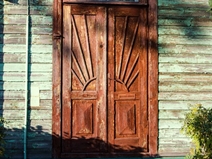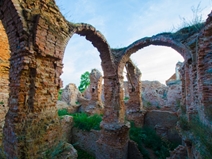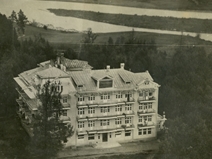Birštonas with its well-established wooden castle on Nemunas slope was first mentioned in the Chronicle of New Prussia of Wigand of Marburg in the XIV century. After the defeat of Teutonic Knights in the Battle of Grunwald, Birštonas was for a while known as the hunting estate of the dukes of the Grand Duchy of Lithuania. Until the mid XVI century the city was naturally grew in a linear plan. During 1555-1563 it was expanded to the west and the east by applying a rectangular (Gothic) plan common for urban reforms at that time. However, Birštonas as a trade and crafts city appeared to be overrated and was quickly pushed out of the market by nearby Prienai in the late XVI century, leading to the abandonment of the newly designed street network. As a result, Birštonas became one of the few Lithuanian cities not to adopt the standard rectangular plan and in XVII – early XIX centuries the city formed a completely new unique street network[1].
The revival of Birštonas began in the mid XIX century after learning about the therapeutic effect of the mineral waters found in the area. “It is known that doctor Benediktas Balinskis who worked in Stakliškės resort brought a patient to Birštonas in 1846 who was treated by the local waters. In 1854 Birštonas received an official permission to provide treatment by mineral waters.”[2] The use of therapeutic water required infrastructure which spurted the urban development of Birštonas as a balneological resort. At that time Birštonas only had about 30 houses, while in 1861 the number already reached 52. Urban development of Birštonas was encouraged by the fire that broke out in the nearby Stakliškės resort in 1857, after which the resort lost all of its value. Birštonas was built according to the street network that emerged in the early XIX century: “along the street leading to the resort (in the southern part of the city) and along the road leading to Prienai. These were small wooden peasant huts[3]”. Although in the second half of the XIX century Birštonas was already a well-known balneological resort in Russian Empire, its look was similar to most other Lithuanian villages. It only got its characteristic urban composition in the early XX century, following the erection of a Neo-Gothic church, larger residential houses and public buildings, and treatment facilities. “Just before the First World War city's treatment facilities had a total of 72 baths, while the city had 3 hotels with a total capacity of 200.”[4]
Birštonas was hard-hit by World War I and was nearly abandoned due to the lack of funds for its rebuilding in the early years of Lithuanian independence. In this case, Lithuanian Red Cross organization played a crucial role by offering to modernize Birštonas in 1924 and building the first modern treatment facilities in the city. All profit of Red Cross sanatorium went towards the development of infrastructure. The organization built a modern Red Cross treatment complex, installed electricity, water supply, and sewerage in hotels, allowing the only Lithuanian treatment resort to be able to serve a large number of visitors by the 40s. “Thanks to Red Cross's board, we sorted out the park, built a fountain, set up reservoirs for fresh and mineral water on Vytautas Hill, [...] arranged regular commutes to Kaunas and Alytus. The city saw a growth of sanatoriums and villas, it became nicer, expanded.”[5] By the time it became the centre of the parish in 1933, it already had a market and more than a dozen commercial establishments. At that time, Birštonas was still expanding according to the same composition which formed in the XIX century; it had its central square restored, where in 1939 a monument for patriarch J. Basanavičius was built. Its restructuring plans drawn up in the late 30s, which were supposed to radically change its historical plan, were not implemented due the outbreak of World War II. During the Soviet period, its cityscape, which used to be dominated by one-storey houses with attics, changed significantly: residential zones were built up by typical blocks of flats; new massive treatment complexes were designed.
[1] Miškisnis A. Birštono miesto istorinis-urbanistinis vystymasis. Lietuvos TSR architektūros klausimai. Vilnius: 1974, p. 186-187.
[2] Birštono kurortas XIX a. Online Access: http://kvitrina.com/?p=50979.
[3] Miškisnis A. Op. cit., p. 180.
[4] Birštono turizmo informacijos centro informacija.
[5] Ibid.
Architecture of the World’s cities has been always seeking for a social, economical or cultural progress. Nevertheless, the buildings which used to be signs of future in the urban fabric through time turned to be historical artefacts perceived among the society as cultural memory collectors or identity producers, but… they are treaded just as symbols of the past having nothing to do with the idea of progress.
One of the many results of the Modernity we have is discourse on cultural heritage. It approves, legitimates and legislates the relation between ‘the past’ and ‘the present’ [see. E.g. Vienna Memorandum]. Anyway, there still exist many of dispute in architectural heritage practice as well as in theory.
Thus, we have got an aim of our excursion which is to delve deeper into the progressiveness of the historical and contemporary architecture. Buildings which used to ‘scream’ for a future now are eliminated of contemporary planning in purpose to freeze them in time and preserve them from visual influence of the new architecture. The excursion is excellent chance to see architecture of Kaunas from the other point of view and to reveal the progressiveness of the architecture which had been constantly appearing and it does so now in Kaunas urban fabric.
Kastytis Rudokas
Tourist route „Reflections of modernism in the temporary capital of Lithuania“ offers a look into a period of early modernist architecture, which flourished in Lithuania since early 30‘s until the soviet occupation.
The new tendencies of modernism, that spred through the most part of the Western World after World War I, soon found their way into the young Republic of Lithuania. Local architects, that were coming home after studies in Western European universities brought back the new architectural ideas, and transformed them into disctinctive local form, that was later named Kaunas school of architecture. Each of these architects had their own style, marked by their unique variations of modernist elements – either by fusing them with classical architecture, search for so called „national style“ or just by simply trying to adjust those ideas for the local conditions.
During this walk the participants will survey buildings of various types designed by Vytautas Landsbergis-Žemkalnis, Arnas Funkas, Bronius Elsbergas, Stasys Kudokas and some other, more or less known architects. The route itself goes trough two main ranges of Lithuanian interwar modernism – the main part of central Kaunas called Naujamiestis, and also the district of Žaliakalnis, which is known for it‘s wide collection of modernist residential buildings.
Because of the wide dispersion of included buildings, the route is split in two parts. First part, which extends through Naujamiestis is intended for pedestrians, and the second part that includes objects in Žaliakalnis district, that serves as an additional branch for the main route, recommended for cyclists and those who enjoy long walks.
Paulius Tautvydas Laurinaitis
Soviet period has drastically changed the urban face of Kaunas. Though the main transformation was rapid expansion of the city, during which many new residential and industrial districts were developed, central part of the city has changed too. Our short tourist route illustrates the main architectural events in Naujamiestis district during this period.
The best place to start our walk through examples of Soviet architecture in central Kaunas is the railway station. One of the first buildings built in the city after the war, the station itself is a good example of so called socialist realism, also known as the „Stalinist style“. The main principles of this style are clearly seen in both the interior and the exterior of the station, that is „national by it‘s form, but socialist by spirit“. Other good examples of socialist realism include buildings at 81 and 100 Laisvės avenue and „Pergalė“ factory housing blocks.
Radical political changes, that followed Soviet communist party congress in 1956 also influenced architectural trends in whole country: prevalent socialist realism was substituted by international modernism. Although Soviet interpretation of modernist ideas is most commonly associated with typical housing blocks suited for „minimal existence“ of the working class, objects located in central part of the city also show the other side of Soviet architecture. Buildings like cinema „Planeta“, hotel „Baltija“, „Buitis“ department store and some others indicate about objectives to find original architectural approach in the times of bad quality construction materials and outdated building technology.
Architectural possibilities started to expand only in the late Soviet period. Postmodern M. Žilinskas art gallery, interrior of „Viltis“ pharmacy, and already demolished „Merkurijus“ department store all illustrate the more original and individualistic approach, that became available to the architects just before the collapse of the Soviet union. Kaunas still have two unfinished objects from this period, reffered by locals as „ghosts“ and „monsters“. These concrete buildings were supposed to become hotels, but the lack of funding halted the construction, and to this day both remain abandoned.
Even though Soviet era architecture is still considered controversial, the wide spectrum of functional types, style interpretations and distinctive urban solutions in such comparatively small area, shows us the importance of political decisions, that influenced architecture during whole socialist period. It also gives us unique insight of how architects of the time coped with creative restraints induced by the strict system.
Vaidas Petrulis
“(...) Marvelous places! It is hard to imagine: suddenly come across something like impassable forests, cozy paths of the city among small houses, intact scarps, and again vernal gardens; therefore – wonderful…[1]”
Mikalojus Konstantinas Čiurlionis
Resort architecture started to form in the middle of XIX c. As being very recent started to express quite significant and to develop equivalent[2]. This period was toward to start the creation work of canon architecture for the rest. Parallel withal this trend the main recreational centers of Lithuania started to develop. One of the most important balneologic type resort located in southern part of the country is Druskininkai.
Resort, which is famous by numerous array of the forests, moss hills and wealth’s of the mineral waters and curative mud, dominate the peculiar architecture (mostly wooden) which is typical only for this region. From 1794, when Druskininkai by special decree were announced a curative area, borders of health-resort town formed around reservoirs of mineral springs in the current territory of old town. Following type buildings developed: villas, spa, colonnades, hotels, sanatoriums and else. Leisure culture and constructions of recreational architecture started to momentum in Druskininkai a few years last till the World War I (around 1910) and reached its apogee in the period of interwar (1918-1940).
The trends of the constructions of objects for the rest, like in the other the same kind of foreign resorts (Zakopane / Poland, Jūrmala / Latvia, Baden-Baden / Germany etc.) depended on the prevailing political system. Along the general trends of stylistics the regional identity was significant which was inspired by the taste of those days society as well. Traveling this route it is important to perceive that such typology of the cities architecture characterized sensuous human relationship with the environment and one-side ideology disappeared. All epochs and styles architecture there was dominated and tolerated, which met intensively changing needs of holidaymakers and therefore had to be versatile and intriguing[3].
Before World War I Druskininkai belonged to the czarist government, that’s why for the stylistic trend of resorts recreational architecture it is characteristic the Russian décor. The mostly typical examples of resort architecture in the city till nowadays remains from the period of Polish occupation – villas of Swiss (akin to “Zakopane” style) and German type.
The silhouette of interwar Druskininkai was variegated not only by small-high wooden summerhouses and the roofs peaks of villas but also by large horizontal clearly distinguished volume of Physiotherapy hospital. During this period Druskininkai formed its traditional resort identity. Unique nature and the harmony of sustainable architecture caused the birth of peculiar cultural identity, the high quality of therapeutic services (“(…)the resort was affordable only for rich”[4]) and inexorably growing popularity of the city.
Prepared by Viltė Migonytė
[1] Медонис А. Друскининкай. Vilnius: Valstybinė politinės ir mokslinės literatūros leidykla, 1961.
[2] Tutlytė, Jūratė. Rekreacinė architektūra Lietuvos kurortuose (1940-1990 m.): kompleksinis kokybės vertinimas: humanit. m. dr. disertacija. VDU. Kaunas, 2002, p. 61.
[3] Ptašek, Maja. Medinė kurortų architektūra. Vilnius: Vaga, 2002, p. 111.
[4] Jušėnaitė J., Medonis Ar., Druskininkai. Vilnius: Valstybinė politinės ir mokslinės literatūros leidykla, 1956, p. 22.


![TEXT[ILE] ROUTES: soviet time textile architecture in Kaunas](/Route/Image/13)


![TEKST[IL]INIAI MARŠRUTAI: XVIII a. pab. - XX a. pr. su tekstilės pramone susijusių pastatų architektūra Kaune](/Route/Image/9)




